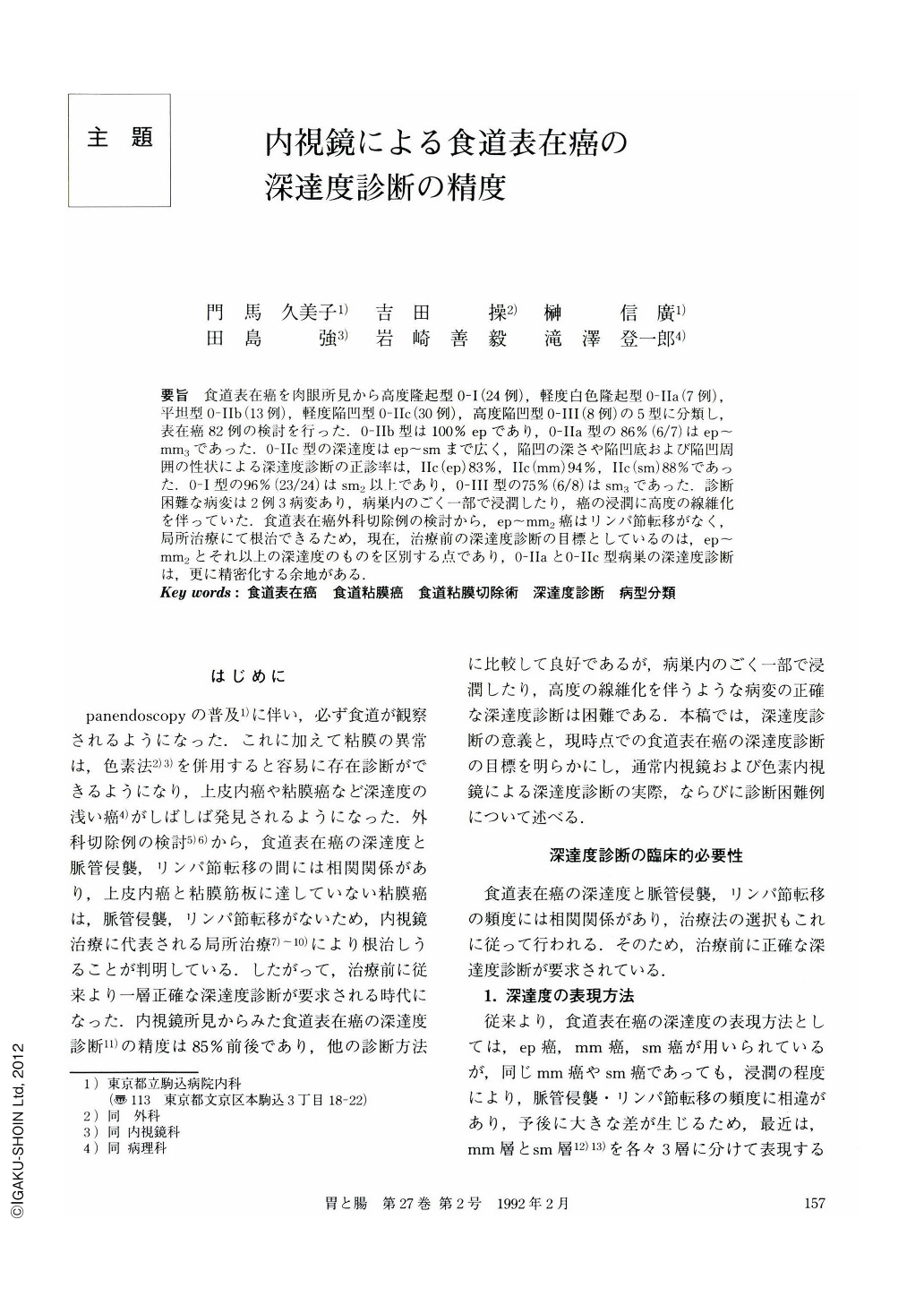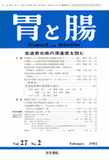Japanese
English
- 有料閲覧
- Abstract 文献概要
- 1ページ目 Look Inside
- サイト内被引用 Cited by
要旨 食道表在癌を肉眼所見から高度隆起型0-Ⅰ(24例),軽度白色隆起型0-Ⅱa(7例),平坦型0-Ⅱb(13例),軽度陥凹型0-Ⅱc(30例),高度陥凹型0-Ⅲ(8例)の5型に分類し,表在癌82例の検討を行った.0-Ⅱb型は100%epであり,0-Ⅱa型の86%(6/7)はep~mm3であった,0-Ⅱc型の深達度はep~smまで広く,陥凹の深さや陥凹底および陥凹周囲の性状による深達度診断の正診率は,Ⅱc(ep)83%,Ⅱc(mm)94%,Ⅱc(sm)88%であった.0-Ⅰ型の96%(23/24)はsm2以上であり,0-Ⅲ型の75%(6/8)はsm3であった.診断困難な病変は2例3病変あり,病巣内のごく一部で浸潤したり,癌の浸潤に高度の線維化を伴っていた.食道表在癌外科切除例の検討から,ep~mm2癌はリンパ節転移がなく,局所治療にて根治できるため,現在,治療前の深達度診断の目標としているのは,ep~mm2とそれ以上の深達度のものを区別する点であり,0-Ⅱaと0-Ⅱc型病巣の深達度診断は,更に精密化する余地がある.
Purpose of this paper is to analize 82 cases with superficial esophageal cancer treated by radical esophagectomy (60 cases) or endoscopic mucosectomy (22 cases) at our hospital, and to evaluate recent status of endoscopic estimation of the depth of invasion in superficial esophageal cancer. Histological grade of the depth of cancer invasion was categorized into seven groups: intraepithelial cancer (ep), slight invasion into the lamina propria (mm1), moderate (mm2), severe (mm3), slight invasion into the submucosa (sm1), moderate (sm2) and severe (sm3). Revised endoscopic classification of superficial esophageal cancer was also employed.
A) Survival rate and the depth of invasion in patients with radical esophagectomy. There were 7 (ep), 13 (mm) and 40 (sm) cancer cases in which esophagectomy was performed. Clinicopathological analysis of these cases revealed that ep-mm2 cases had no microvascular invasion or lymph node metastasis. Vascular invasion was found in 38% and lymph node metastasis 13% of cases with mm3 or sm1 cancer.
On the other hand, vascular invasion was frequently seen in sm2 and sm3 cases (84% and 94%) as well as lymph node metastasis (37% and 50%). Five-years urvival rate was 100% for ep-sm1, 80% for sm2, and 43% for sm3. These findings suggested that eradication of the lesion with the depth of invasion ep-mm2 including the underlying submucosa was satisfactory as radical treatment. And thus the purpose of estimating the depth of invasion at present is to differentiate ep and mm1-2 from other groups.
B) Endoscopic estimation of the depth of invasion. Eighty-two cases with superficial esophageal cancer were classified into (1) distinctly protruding type (0-Ⅰ) 24 cases, polypoid (0-Ⅰp) 8 cases, plateau-like (0-Ⅰpl) 11cases, subepithelial (0-Ⅰsep) 5 cases, (2) slightly protruding type (0-Ⅱa) 7 cases, (3) flat type (0-Ⅱb) 13 cases, slightly depressed type (0-Ⅱc) 30 cases and distinctly depressed type (0-Ⅲ) 8 cases. All cases with Ⅱb type was ep cancer, 95% of 0-Ⅰ sm1 or sm3, all of 0-Ⅲ sm2 or sm3. 0-Ⅱa lesions had invasion from ep to sm1. Grade of protrusion and irregularity in surface appearance was related to the depth of invasion. 0-Ⅱc lesions suggested the widest distribution of the depth of invasion. Endoscopic estimations were based on the surface appearance of depressed area and characteristics shown by toluidine blue staring. In cases of Ⅱc (ep), depression was minimal and it looked smooth with weak positive staining to toluidine blue. Incases of Ⅱc (mm), the depressed area showed fine to coarse granular changes and frequently had spotty, mesh-like or macular stain to toluidine blue. Accuracy rate in estimating the depth of invasion in 0-Ⅱc lesions were 83% for ep, 94% for mm and 88% for sm.

Copyright © 1992, Igaku-Shoin Ltd. All rights reserved.


